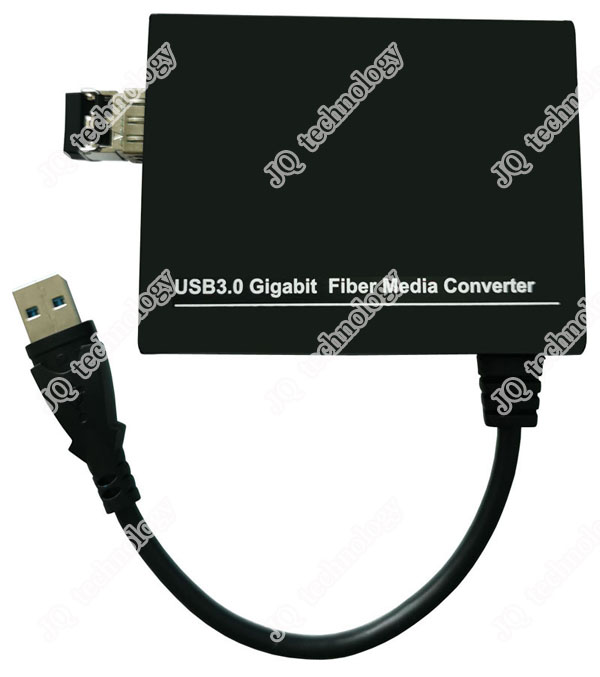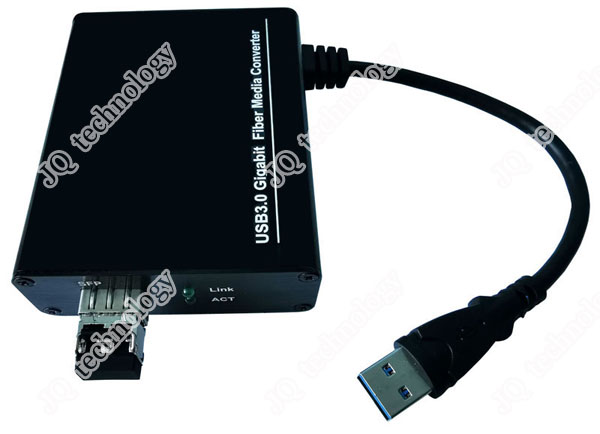USB3.0 gigabit fiber media converter


JQNIC-SFP can solve the problems arising from the traditional integrated computer that fiber access can be realized only by fiber transceiver (transfer from optical signal to electronic signal). It offers optimal design in adopting small pluggable slot that can be compatible to all SFP gigabit module through exchanging SFP module to maximize the usage needs for various networking environments. By testing, under USB3.0, transmission rate will reach to the maximization of gigabit speed 1000Mbit/s so as to meet the huge data transmission requirements.
JQNIC-SFP is completely different from the mini NIC with plastic shell in nature. Its appearance is unique in current market for its aluminium shell, which helps to ensure the high performance. It can be placed either upright or horizontal as you need. The elegant appearance can enhance the glorious outlook in the office. Besides, aluminium shell has the good thermal dissipation overcoming the shortage of the plastic shell to ensure the reliability and working stability, it offers well-deserved reputation of “classic” in the market.
JQNIC-SFP provide higher bandwidth and improved protocols for data exchange between the host and the device. USB 3.0 also offers more advanced power management features for energy saving. Its Advanced Configuration Power management Interface (ACPI)—power management for modern operating systems that are capable of Operating System-directed Power Management (OSPM)—is supported to achieve the most efficient power management possible. In addition to the ACPI feature, remote wake-up (including AMD Magic Packet and Microsoft Wake-Up Frame) is supported in both ACPI and APM (Advanced Power Management) environments.
JQNIC-SFP supports Microsoft Wake Packet Detection (WPD) to provide Wake-Up Frame information to the OS, e.g., Pattern ID, Original Packet Size, Saved Packet Size, Saved packet offset, etc. WPD helps previent unwanted/ unauthorized wake-up of a sleeping computer.
JQNIC-SFP supports Protocol offload. It offloads some of the most common protocols to NIC hardware in order to prevent spurious wake-up and further reduce power consumption. JQNIC-SFP can offload ARP (IPv4) and NS (IPv6) protocols while in the D3 power saving state.
JQNIC-SFP supports the ECMA (European Computer Manufacturers Association) proxy for sleeping hosts standard.
JQNIC-SFP supports IEEE802.3az-2010, also known as Energy Efficient Ethernet (EEE). IEEE 02.3az2010 operates with the IEEE 802.3 Media Access Control (MAC) Sublayer to support operation in Low Power Idle mode. When the Ethernet network is in low link utilization,EEE allows systems on both sides of the link to save power.
JQNIC-SFP is fully compliant with Microsoft NDIS5, NDIS6 (IPv4, IPv6, TCP, UDP) Checksum features,and supports IEEE 802 IP Layer 2 priority encoding and IEEE 802.1Q Virtual bridged Local Area Network (VLAN).
The above features contribute to lowering CPU utilization, especially benefiting performance when in operation on a network server. JQNIC-SFP is suitable for multiple market segments and emerging applications, such as desktop, mobile, workstation, server, communications platforms, docking station, and embedded applications.
Features
Fiber Port supports 1000Mbase-SX/LX standard;
Supports USB 3.0, 2.0, and 1.1;
Supports LPM (Link Power Management);
Supports pair swap/polarity/skew correction;
Crossover Detection & Auto-Correction ;
Supports Wake-On-LAN and 'RealWoW!' (Wake-OnWAN)Technology (see note 1);
Supports power down/link down power saving;
Transmit/Receive on-chip buffer support;
Supports hardware CRC (Cyclic Redundancy Check)function;
Supports Microsoft NDIS5, NDIS6 Checksum Offload (Ipv4, IPv6,TCP, UDP) and Segmentation Task-offload (Large send v1 and Large send v2)
Supports jumbo frame to 9K bytes;
Supports Full Duplex flow control (IEEE 802.3x);
Fully compliant with IEEE 802.3 and IEEE 802.3u;
Supports IEEE 802.1P Layer 2 Priority Encoding;
Supports IEEE 802.1Q VLAN tagging;
Supports IEEE 802.3az-2010 (IEEE);
Operating System
Windows xp 32bit/64bit
Windows vista 32bit/64bit
Windows 7 32bit/64bit
Windows 8 and 8.1 32bit/64bit
Linux
Product dimension
89*71*25mm (without SFP transceiver)
108*71*25mm (with SFP transceiver)

